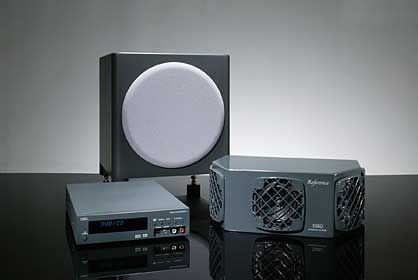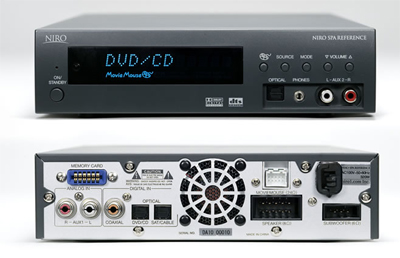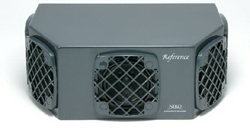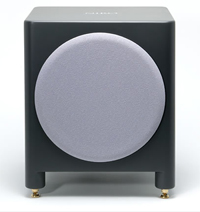You are reading the older HTML site
Positive Feedback ISSUE
18
march/april 2005
niro
Reference Home Theater System
as reviewed by Larry Cox

|
LARRY COX'S SYSTEM LOUDSPEAKERS ELECTRONICS SOURCE CABLES ACCESSORIES
|
In Issue 13, I wrote about the Niro 1.1 Pro. At $799 for a complete home theater system, I thought it was the best audio buy I had come across in more than ten years of reviewing audio gear. Designed for rooms of 500 to 600 square feet, it more than filled my room, though its sweet spot did not extend throughout the entire space. It is necessary for listeners to be in the sweet spot to get a full three-dimensional image, but near-sighted people would sit there anyway. The 1.1 Pro provided a very satisfying home theater experience. I've had it and used it for nearly a year, and still think so.
The sound quality, while very good, is not to the same standard as my two-channel system, but that system cost nearly thirty times as much! The sound quality of the 1.1 Pro is much better than that of most systems at its price level. Distortion iss hard to detect, and the sound is sweet in an almost tubey way. It may be overly sweet, but given the price, the sound quality is far far better than I'd have thought possible. There's really no way you can have a sense of how good the 1.1 Pro sounds like by reading a review, but take my word for it—it's darned good.
Among the things I liked about the 1.1 Pro was that it provided a simple, complete home theater system that didn't make large space demands. All of the speakers are in one part of the room, with no need to snake wires under—or even on—the floor. All of the wires you need, including the ones for the subwoofer and speakers, are included. In our simpler-is-better household, it is a great fit. It has never seemed less than a great buy, though on occasion, minor digital artifacts would show up from the included DVD player. Niro's new home-theater-in-a-box no longer includes a DVD player. Instead, you get the main speaker and subwoofer plus a surround processor, amplifier, and all necessary wiring. Also gone from the package is the AM/FM tuner.

The Niro Reference loudspeaker is 19 inches wide, 4.3 inches high, and 7.9 inches deep. It comes in a gun-metal grey color which is less attractive than the 1.1 Pro's silver with white fabric covering. The subwoofer is the same size as the 1.1 Pro—11.7 inches wide by 12.9 inches high by 11.7 inches deep—weighs 14.3 pounds. The processor/amplifier is even smaller than the already small Niro 1.1 Pro receiver. I also received a rather brilliant little addition called the Movie Mouse—more about that later. The Niro Reference supports Dolby Pro Logic and Dolby Digital. While the remote is a bit packed, you'll soon find your way around it, even in the dark. Press a button on the remote and all of the functions light up.
 The Niro Reference system offers a bona fide home
theater experience without five speakers taking over your home. There's just one
shielded speaker that can sit on top of most televisions, plus a front-firing
subwoofer. Niro has developed a set of algorithms that allows five speakers in
one box to create a three-dimensional sound experience. I just plopped the
system down and it sounded great. I'd say that most people shopping for a home
theater system under $4000 would be wasting their time and money looking
elsewhere, unless it is Niro's 6.1 system, which I haven't heard.
The Niro Reference system offers a bona fide home
theater experience without five speakers taking over your home. There's just one
shielded speaker that can sit on top of most televisions, plus a front-firing
subwoofer. Niro has developed a set of algorithms that allows five speakers in
one box to create a three-dimensional sound experience. I just plopped the
system down and it sounded great. I'd say that most people shopping for a home
theater system under $4000 would be wasting their time and money looking
elsewhere, unless it is Niro's 6.1 system, which I haven't heard.
 The Niro
Reference played loud enough to fill my room without sounding hard or congested,
or otherwise telling me that it was over its limit. How speakers this small can
produce so much output AND sound so good is hard to fathom, but easy to enjoy. Niro calls this one-speaker surround
sound, but that's not accurate. When I think of surround sound, I think of
hearing things happening in front and behind my head. You won't hear sounds
coming from behind you with the Niro Reference system. However, the system more
than ably conjured up a sense of a 3-D environment, with lots of spatial cues in
front of you. Usually, that is how I experience movies in theaters.
The Niro
Reference played loud enough to fill my room without sounding hard or congested,
or otherwise telling me that it was over its limit. How speakers this small can
produce so much output AND sound so good is hard to fathom, but easy to enjoy. Niro calls this one-speaker surround
sound, but that's not accurate. When I think of surround sound, I think of
hearing things happening in front and behind my head. You won't hear sounds
coming from behind you with the Niro Reference system. However, the system more
than ably conjured up a sense of a 3-D environment, with lots of spatial cues in
front of you. Usually, that is how I experience movies in theaters.
The Reference is rated for the same size room as the 1.1 Pro. That is, 500-600 square feet–about the size of my front room, although I have cathedral ceilings that rise to fourteen feet, and the left side opens into another room. The main difference is that the Reference is designed to have a larger sweet spot than the 1.1 Pro. While the 1.1 Pro does fine in my large listening space, the Reference sounds a bit better.
Every review needs to include a "confession" of the reviewer for the reader to divine its full meaning. Many omit this, but here's my confession: I love movies. I love talking about them, being caught up in figuring out what the heck happened in Mulholland Drive, L.A. Confidential, or the like. However, I'm not usually glued to the television. The last broadcast TV we watched at home was the recall debate of California's governor, about two years ago. We do watch movies more frequently, as much as three times a week. Although we're not plastered to the sofa, we do enjoy a high-quality experience. I had The Niro Reference in the house for several months, and watched quite a few movies. It nearly always made the experience a joy. Whether they were visual and aural assaults like the Bourne collection, "talkie" movies like Enlightenment Guaranteed, or movies with great music like The Pianist, the experience was delightful.
If you enjoy movies but are not willing to surrender your home to hardware, the Niro Reference could be for you. On the night that the director's cut of The Lord of the Rings: The Return of the King was released, I invited friends over to watch it. In the house were six guests and an Epson Powerlite 51c, a DLP projector with XGA resolution, and the Niro Reference. The experience was fabulous—truly transformative. Though the image was not as large as in a theater, our proximity to the TV allowed retrieval of an amazing amount of visual information. With the Reference pumping out music and sound effects, we all agreed that the experience was superior to being in a theater. There was enough bass to get a sense of Oliphaunts trundling through our living room. Gollum was easy to understand, and other small sonic details were easy to hear. Even though the complete setup was under $4000, there was nothing lacking from a great home theater experience. I don't mean for the money, I mean that for less than $4000, we truly had a luxury experience.
As a result of the director's cut night, I have become known as the crack dispenser. Friends have opened their wallets for audio products I've introduced them to, and the Niro products have created passion and enthusiasm. The Niro system is so small that you might not even notice it. Ditto for the Epson and Dalite screen. When you're done with them, you can put them in another room or in a closet, and bring them out when it's movie night.
I've waxed enthusiastic over both the 1.1 Pro and the Reference. Which should you buy? In a smaller room, the 1.1 Pro will be fine. Heck, it's even fine in a larger room. If your house is heavily damped, the slightly brighter sound of the 1.1 Pro will be a great choice. In a more reverberant room, the Reference may be better. In truth, I preferred the sweeter sound of the Reference, although I sometimes tilted up the treble balance for better dialogue clarity.
Compared to the 1.1 Pro, the Reference is more refined, and is also able to play louder. The Reference sounds a little softer, with a more relaxed midrange. This was great with well-miked movies. With not-so-well-miked movies, I found myself turning up the treble. The 1.1 Pro didn't seem to have any noticeable distortion artifacts, but that was before I installed the Reference. It took a bit of edge off, though ironically that same edge seemed to make dialogue easier to hear. For us, the Reference is simply a better choice. We have a big room that we share with friends and family, and being able to include more people in the sound field is better. I also preferred the backlit remote that comes with the Reference.
The remote also includes a special section for the Movie Mouse, a miniature version of the standard Reference speaker that is meant to be placed within about one meter of the listeners. Select the Movie Mouse on the remote, and the subwoofer is automatically switched off, leaving the five drivers in the Movie Mouse providing all of the sound. With the speaker nearer you, the volume levels don't need to be as high to allow dialogue and special effects to be easily intelligible. It allows for a completely immersive experience for one or two people, while leaving people in another part of the house oblivious to your activities. I tried placing the Movie Mouse completely off axis, while sitting at a forty-five degree angle to the picture. It shouldn't have conveyed a 3D experience, but it sure as heck did.
What I absolutely loved about both the 1.1 Pro and the Reference was having a simple setup. My only caveats are that the speakers need to be placed so that sound can expand out into the room and create an open sound field. If you have a large entertainment center, you'll have to place the Niro speaker on top of it, or find another place to put it. If you can accommodate that, the Niro Reference will deliver an exceptional home theater experience without holding your house hostage. Larry Cox
Reference
Retail: $1090 plus shipping
Niro
web address:
www.niro1.com
